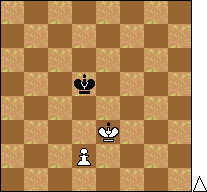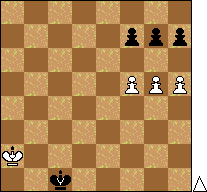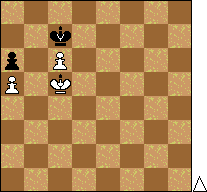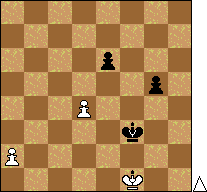By Matthew Grinberg, Founder of Alamogordo Chess Club
- This little puzzle of mine illustrates two of the most the most basic and important things about pawn endgames – the opposition and keeping your king in front of your passed pawn.

The opposition is one form of zugswang – putting your opponent in a position where any move he makes weakens his position. Having the opposition in a pawn endgame means having the opponent’s king two squares away from your own king on a file, rank or diagonal with your opponent on the move. The best form of the opposition in a pawn endgame having your king directly in front of your opponent’s king with your pawn behind you so his king will be forced to step aside or back up, allowing your king to advance.
The importance of keeping your king in front is that it not only allows you to set up the opposition, but the king acts like a bulldozer, clearing the way for your pawn.
White to play and win.
- Kd3! White both steps in front of his passed pawn and takes the opposition. Every other move in this position allows a draw.
[1. d4? Kd6 2. Ke4 Ke6 3. d5 Kd6 4. Kd4 Kd7 5. Ke5 Ke7 6. d6 Kd7 7. Kd5 Kd8 This move illustrates an important point for the defender in pawn endgames – when forced to drop back by a pawn directly in front of you defended by the opponent’s king, it is best to drop directly back, not diagonally. (7… Ke8? 8. Ke6 Kd8 9. d7 Kc7 10. Ke7 Kc6 11. d8=Q White wins) 8. Ke6 Ke8 9. d7 Kd8 10. Kd6 stalemate;
- Kf3? Kd4 2. Ke2 Ke4 3. d3 Kd4 4. Kd2 Kd5 5. Ke3 Ke5 6. d4 Kd5 and we have reached the same position as after White’s first move in the previous line. Draw]
1… Ke5
[1… Kd6 Stepping back directly when the opponent’s king is in front of the pawn does no good because your opponent will step forward directly retaining the opposition 2. Kd4]
- Kc4 Ke6
[2… Kd6 3. Kd4 Ke6 4. Kc5 Kd7 5. Kd5 Ke7 6. Kc6 Kd8 7. Kd6 Ke8 8. d4 Kd8 9. d5 Kc8 10. Ke7 Kc7 11. d6 Kc6 12. d7 Kd5 13. d8=Q White wins]
- Kc5 Ke5 Black’s king takes the opposition on a rank, but it is futile because White advances his pawn, forcing Black’s king to move.
- d4 Ke6 5. Kc6 Ke7 6. d5 Kd8 7. Kd6 Once again White takes the opposition with his pawn behind his king forcing Black’s king aside so White’s king can step up to cover the last two squares the pawn needs to queen.
7… Ke8 8. Kc7 Ke7 9. d6 Ke6 10. d7 Ke5 11. d8=Q White wins [1:0]
2.
This problem illustrates what I call the “pawn breakthrough” – a well-known theme in pawn endgames. But, oops, I made a mistake in setting up the position. White’s king should have been on a1, not a2. On a1 the intended solution, 1. g6, is the only solution. As it is, White has two alternatives. But this allows me to go into further depth in the realm of pawn endgames.
White to play and win.

- g6! Black must capture else White’s g-pawn will quickly queen.
[1. Ka1??? turns the game on its head and allows Black to win by playing g6 first and getting his king to the pawns first. 1… g6 (1… Kc2 2. Ka2 Kc1) 2. hxg6 hxg6 3. fxg6 (3. f6 Kd2 4. Kb2 Ke3 5. Kc3 Kf4 6. Kd4 Kxg5 7. Ke5 Kh5 8. Kf4 (8. Kd6 g5 9. Ke7 Kg6 Black wins) 8… g5 9. Kg3 (9. Kf5) 9… Kg6 10. Kh3 Kxf6 Black wins) 3… fxg6 4. Ka2 Kd2 5. Kb3 Ke3 6. Kc2 Kf4 7. Kd1 Kxg5 8. Ke2 Kg4 9. Kf2 Kh3 10. Kg1 g5 11. Kh1 g4 12. Kg1 Kg3 Black takes the opposition and wins. 13. Kh1 Kf2 14. Kh2 g3 15. Kh3 g2 16. Kg4 g1=Q Black wins;
- Kb3 g6 (1… Kd2 2. g6 hxg6 3. f6 gxf6 4. h6 White wins as in the main line) 2. hxg6 hxg6 3. fxg6 fxg6 4. Kc3 Kd1 5. Kd4 Ke2 6. Ke5 Kf3 7. Kf6 Kf4 8. Kxg6 White wins;
Even this move wins. 1. Ka3 g6 (1… Kd2 2. g6 hxg6 3. f6 gxf6 4. h6 f5 5. h7 f4 6. h8=Q f3 7. Qd8 Ke2 8. Qe7 Kf1 9. Qxf7 f2 10. Qe6 Kg1 (or 10… g5 11. Kb3 Kg1 12. Qg4 Kh2 13. Qf3 g4 14. Qxf2 Kh3 15. Kc2 g3 16. Qf4 g2 17. Qg5 g1=N 18. Qxg1 Kh4 19. Kd3 Kh5 20. Qg7 Kh4 21. Ke3 Kh5 22. Kf3 Kh4 23. Qg4#) 11. Qg4 (Not 11. Qxg6?? which leads to a theoretical draw. One of three things will happen, Black will queen the pawn, Black will be stalemated on h1 when White captures the pawn with his queen, the position will be repeated three times allowing Black to claim a draw or 50 moves will be played without anything being captured or the pawn moving, allowing Black to claim a draw. The one thing Black must avoid to secure the draw is stepping his king in front of the pawn since that would allow White’s king to move towards the kingside. I note that the position would also be a draw if Black’s pawn was on h2.) 11… Kh2 12. Qf3 Kg1 13. Qg3 Kf1 14. Kb3 Ke2 15. Qg4 Ke1 16. Qe4 Kd2 17. Qd5 Ke2 18. Qg2 Ke3 (18… Ke1 19. Kc2 Ke2 20. Qe4 Kf1 21. Qg4 g5 (21… Ke1 22. Qd1#) 22. Kd3 Ke1 23. Qe2#) 19. Kc2 g5 20. Kd1 Kf4 (20… g4 21. Qg3 Ke4 22. Qxf2 White wins) 21. Qxf2 White wins) 2. hxg6 hxg6 3. f6 Kd2 4. Kb4 Ke3 5. Kc5 Kf4 6. Kd6 Kxg5 7. Ke7 Kh4 8. Kxf7 g5 9. Ke6 g4 10. f7 g3 11. f8=Q Kh3 12. Ke5 Kg2 13. Ke4 Kg1 14. Qh6 g2 15. Kf3 Kf1 16. Qh3 Ke1 17. Qxg2 Kd1 18. Qb2 Ke1 19. Qc1#]
Back to the main (intended) line. 1… hxg6
[Or 1… fxg6 2. h6! and White will win much as in the main line. 2… gxh6 3. f6 Kd2 4. f7 Ke3 5. f8=Q g5 6. Qxh6 Kf4 7. Qxh7 g4 8. Qh2 Kf3 9. Qg1 White wins]
- f6! Now no matter what Black does, White’s f-pawn or h-pawn will queen.
2… gxf6 The best hope since Black ends up with three pawns for the queen.
- h6 Kd2 If Black does not move his king towards the pawns, they will all be quickly lost.
- h7 Ke3 5. h8=Q f5 6. Qe8 Kf3 7. Qxf7 f4 8. Qxg6 Ke3 9. Qg2 f3 10. Qf1 Black’s pawn is no longer a threat to queen. Meanwhile White will bring his king over the finish the deal.
10… Ke4 11. Kb3 Ke3 12. Kc4 Ke4 13. Qf2 Ke5 14. Qxf3 Ke6 15. Qf4 Kd7 16. Kd5 Ke7 17. Qf5 Kd8 18. Kd6 Ke8 19. Qf1 Kd8 20. Qf8# [1:0]
3.
I saw this puzzle a long time ago. I can’t remember where, but when I saw the solution, it was permanently imprinted in my brain,
In order to win, White has to get back to the original position, but with Black to move. If he does that, then he will win Black’s last pawn and the game.
The idea of getting back to the original position with the opposite side to play is called “triangulation.” The idea is that the player on the move has three safe squares for his king but the opponent’s king only has two. But in this case there are more squares involved and it takes more than the three moves implied by the term.

White to play and win.
- Kd5
1… Kc8
[1… Kd8 Allows White to win faster. 2. Kd6 Kc8 3. c7 Kb7 4. Kd7 Ka8 5. c8=Q Ka7 6. Qg8 Kb7 7. Qb3 Ka8 8. Kc6 Ka7 9. Qb7#;
1… Kb8 Allows White to win faster. 2. Kd6 Ka7 3. c7 Kb7 4. Kd7 Ka8 5. c8=Q Ka7 6. Qc5 Kb7 7. Qe7 Kb8 8. Kc6 Kc8 9. Qc7#]
- Kd4
[2. Kd6 Works but takes longer. 2… Kd8 3. Kd5 Kc8 4. Kc4 Kd8 5. Kd4 Kc8 6. Kd5 Kc7 7. Kc5 He gets to the key position two moves slower than the main line. 7… Kc8 8. Kb6 Kb8 9. Kxa6 Kc7 10. Kb5 Kc8 11. Kb6 Kd8 12. c7 Kd7 13. a6 Ke6 14. a7 Kf5 15. a8=Q Ke5 16. Qf8 Kd5 17. c8=Q Ke4 18. Qc4 Ke5 19. Qff4#]
2… Kd8
[2… Kc7 Allows White to win faster. 3. Kc5 Kc8 4. Kb6 Kb8 5. Kxa6 Kc7 6. Kb5 Kc8 7. Kb6 Kd8 8. c7 Kd7 9. a6 Ke6 10. a7 Kf5 11. c8=Q Kf4 12. a8=Q Ke5 13. Qf3 Kd6 14. Qf6 Kd5 15. Qcc6#;
2… Kb8 Amounts to the same thing. 3. Kc4 Kc8 4. Kd5 Kc7 5. Kc5 Kc8 6. Kb6 Kb8 7. Kxa6 Kc7 8. Kb5 Kc8 9. Kb6 Kd8 10. c7 Kd7 11. a6 Ke6 12. a7 Kf5 13. c8=Q Kf4 14. a8=Q Ke5 15. Qf3 Kd6 16. Qf6 Kd5 17. Qcc6#]
- Kc4
[3. Kd5 Works but takes longer. 3… Kc8 4. Kc4 Kd8 5. Kd4 Kc8 6. Kd5 Kc7 7. Kc5 Again he has taken two moves longer to get to the key position. 7… Kc8 8. Kb6 Kb8 9. Kxa6 Kc7 10. Kb5 Kc8 11. Kb6 Kd8 12. a6 Ke8 13. c7 Ke7 14. a7 Kd7 15. a8=Q Ke7 16. c8=Q Kf6 17. Qf3 Kg6 18. Qff5 Kg7 19. Qcf8#;
- Kc5 Kc7 Repeats the starting position with White to move – not what White wants unless he is going for a draw.]
3… Kc8
[3… Kc7 Allows White to win faster. 4. Kc5 Kc8 5. Kb6 Kb8 6. Kxa6 Kc7 7. Kb5 Kc8 8. Kb6 Kd8 9. a6 Ke7 10. c7 Kf6 11. a7 Kf5 12. c8=Q Ke4 13. a8=Q Kf4 14. Qg2 Ke5 15. Qgg4 Kf6 16. Qce6#]
- Kd5
[4. Kc5 Kc7 Repeats the starting position with White to move again]
4… Kc7
[4… Kd8 Allows White to win faster. 5. Kd6 Kc8 6. c7 Kb7 7. Kd7 Ka8 8. c8=Q Ka7 9. Qc5 Kb7 10. Qb4 Ka8 11. Kc6 Ka7 12. Qb7#;
4… Kb8 Allows White to win faster. 5. Kd6 Ka7 6. c7 Kb7 7. Kd7 Ka8 8. c8=Q Ka7 9. Qc5 Kb8 10. Qb4 Ka8 11. Kc6 Ka7 12. Qb7#]
- Kc5! White finally gets back to the original position with Black to move!
5… Kc8 6. Kb6 Kb8 7. Kxa6 White wins Black’s lone pawn.
7… Kc7 8. Kb5 Black can no longer stop the pawns from queening.
[Not 8. Ka7?? Kxc6 Draw. White will never be able to queen his remaining pawn]
One possible finish: 8… Kc8 9. Kb6 Kd8 10. a6 Ke7 11. a7 Ke6 12. c7 Kf5 13. a8=Q Kg6 14. c8=Q Kg5 15. Qf3 Kg6 16. Qff5 Kg7 17. Qcf8# [1:0]
4.
This is a problem I composed myself a long time ago.
The theme in this puzzle is “interference” – your opponent has a critical goal, so you throw a piece in his way to stop him from doing it. Often, as in this case, the piece is sacrificed.

White to play and win.
- d5!
[Advancing the passed pawn looks good, but Black’s king runs it down and the game ends in a draw. 1. a4? Ke4 2. a5 Kd5 3. Kf2 Kc6 4. Kf3 Kb5 5. Ke4 (5. Kg4 Kxa5 6. Kxg5 Kb5 7. Kf6 Kc4 8. Kxe6 Kxd4=) 5… Kxa5 6. Ke5 Kb4 7. Kxe6 g4 8. d5 g3 9. d6 g2 10. d7 g1=Q 11. d8=Q=;
- Ke1 Ke3 2. Kf1 Kf3]
Black has to take because otherwise the pawn will queen. 1… exd5 But now Black’s own pawn blocks the path his king needs to intercept White’s a-pawn.
[1… g4 2. dxe6 g3 3. e7 g2 4. Kg1 White wins]
- a4 d4 But with two passed pawns and one further advanced than White’s passed pawn, it looks like Black has a chance.
[2… g4 3. a5 g3 4. a6 g2 5. Kg1 d4 6. a7 d3 7. a8=Q White wins;
2… Ke4 3. a5 Ke5 4. a6 Kd6 5. a7 Kc7 Because his own pawn blocked his path, Black’s king gets there too late. 6. a8=Q White wins]
- a5 d3 4. Ke1 g4 5. a6 g3 6. a7 g2 7. a8=Q Sorry Black, your pawn is one move too late.
7… Kg3 8. Qg8 Kf3 9. Qg5 d2 The last desperate attempt to hold.
- Kxd2 Kf2 11. Qf4 White forces Black’s king in front of his pawn setting up the win.
11… Kg1 12. Ke2 Kh1 13. Qh4 Kg1 14. Kf3 Kf1 15. Qh3 Ke1 16. Qxg2 Kd1 17. Qb2 Ke1 18. Qc1# [1:0]


Enjoy the convenience of playing your favorite casino games anytime, anywhere – all you need is an internet connection and a device to get started.
Get ready to experience the thrill of winning!
Explore, fight, and win in our expansive online world!
This blog helps people like me who have no experience playing chess to become more experienced.
These are very smart chess techniques. Thanks for your useful sharing.
Pawn Endgame game with tricky puzzles but always attracts players
The chess techniques are smarter than the sudoku game.
The chess techniques are smarter than the sudoku game.
This free love feelings quiz reveals how you prefer to give and receive love. The concept of love languages was created by couples counselor Dr. Gary Chapman, who observed that people differ in what sort of interactions make them feel loved. Dr. Chapman described 5 love languages, however our research on over 500,000 volunteers indicates there are actually seven distinct ways of showing love. This quiz measures your preference for all 7 of these modern love styles.
When your love style is being met in your relationships, you feel loved, desired and secure. However, if your love style is not being met, you may feel insecure, taken for granted, and bitter towards your partner. It likely feels as if the two of you speak completely different languages — and as it turns out, you do!
Your relationship will look much different depending on whether or not you and your partner are speaking each others’ language. To get the most out of the 7 Love Styles test, both partners should understand their love style as well as their partner’s. By openly communicating what you need, and listening to what your partner needs, you can develop a more fulfilling relationship. Truity’s full Love Style report includes tips on how to express your needs and how to speak your partner’s love style.
Understanding your Love Style is not a cure-all for relationship issues. As with all things in relationships, the key is putting in the time and effort. A 2020 research survey based on Chapman’s model showed that people who reported that their partners used their love language well had stronger feelings of love and relationship satisfaction than others.
[Link deleted]
Sportszino is a platform valid for all types of players to play the available games there are no age restrictions to play the games everyone can play the games. In this app, you can earn real money by playing the games you have to create a fantasy team participate in events, and earn real cash by winning the games. The games are easy to play all you need to play the games on your phone.
Game Vault 777 is a gaming platform that offers a realistic casino experience on your smartphone and PC. This platform is reliable for both casual and seasonal players. In a friendly UI, it provides a wide range of the latest games with high-quality graphics, such as fish games, card games, slot machines, table games, and more.
Milky Way 777 is an online gaming hub with exciting mobile games offering fun and winning opportunities. It provides you with a hundred fish table games, keno, and slot machine games to keep you entertained.
Game Vault 777 is a mobile gaming app that contains a wide range of exciting games. You no longer need to download multiple apps for your other games because one app stores all the games.
Vblink777 is a popular gaming mobile app that lets users earn money by playing engaging games for free. Widely regarded as one of the top gaming apps in US, This App offers an exciting way to make money while enjoying a fun5, interactive experience.
The correction of the initial setup (king should be on a1 not a2) adds an educational moment: even slight positional changes can dramatically alter outcomes.
Let’s play the game
The game is most exciting
Essa versão não oficial oferece a possibilidade de ouvir músicas sem anúncios, escolher qualquer faixa de forma ilimitada, baixar canções para ouvir sem internet e ajustar a qualidade de áudio para o máximo disponível. Essas funcionalidades tornam a experiência muito mais agradável e próxima do que se obtém pagando pelo plano premium. Com isso, cada vez mais pessoas buscam esse tipo de alternativa, seja para economizar dinheiro, seja para ter mais liberdade ao ouvir música.
The attention to detail and commitment to client success make this service a standout in a competitive market.구글찌라시 Their knowledgeable staff offers insightful guidance and dependable support throughout the entire process.
En yeni güncellemeler, heyecan verici savaşlar ve kusursuz performans — hepsi Null’s Brawl’da seni bekliyor.
The Jack In The Box menu with prices is one of the most widely searched topics for fast-food lovers who want to enjoy variety, taste, and affordability all in one place. Known for its extensive menu, Jack In The Box provides an impressive selection of burgers, tacos, chicken sandwiches, breakfast items, sides, desserts, and beverages that appeal to customers of all ages.
¡Eres genial! Creo que nunca antes había leído algo parecido. Es estupendo encontrar a alguien con tantas ideas originales sobre este tema. De verdad, te agradecemos que hayas iniciado esto. Este sitio web es justo lo que se necesita en internet: alguien con un poco de originalidad. ¡Enhorabuena por aportar algo totalmente nuevo a la web!